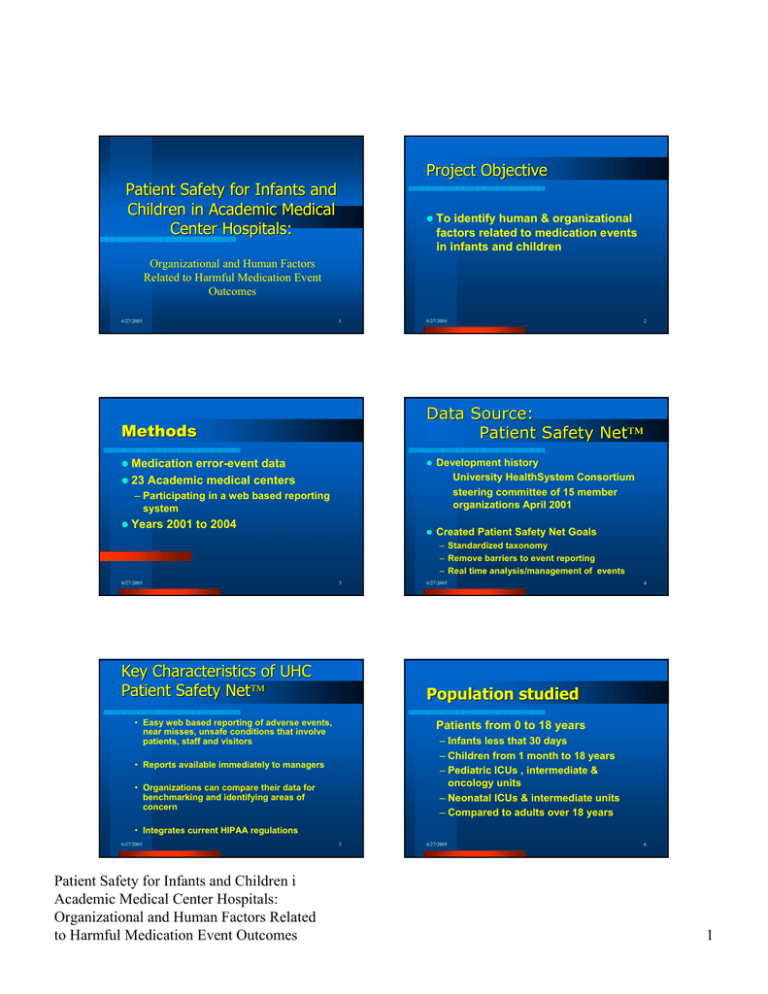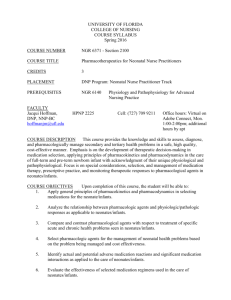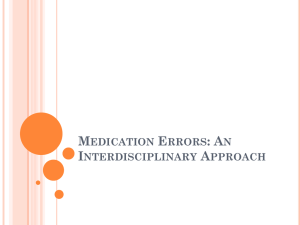Project Objective Patient Safety for Infants and Children in Academic Medical Center Hospitals:
advertisement

Project Objective Patient Safety for Infants and Children in Academic Medical Center Hospitals: z To identify human & organizational factors related to medication events in infants and children Organizational and Human Factors Related to Harmful Medication Event Outcomes 6/27/2005 1 6/27/2005 2 Methods Data Source: Patient Safety Net™ Net™ z Medication z Development history University HealthSystem Consortium steering committee of 15 member organizations April 2001 z Created Patient Safety Net Goals error-event data z 23 Academic medical centers – Participating in a web based reporting system z Years 2001 to 2004 – Standardized taxonomy – Remove barriers to event reporting – Real time analysis/management of events 6/27/2005 3 Key Characteristics of UHC Patient Safety Net™ Net™ 6/27/2005 4 Population studied • Easy web based reporting of adverse events, near misses, unsafe conditions that involve patients, staff and visitors Patients from 0 to 18 years – Infants less that 30 days – Children from 1 month to 18 years – Pediatric ICUs , intermediate & oncology units – Neonatal ICUs & intermediate units – Compared to adults over 18 years • Reports available immediately to managers • Organizations can compare their data for benchmarking and identifying areas of concern • Integrates current HIPAA regulations 6/27/2005 Patient Safety for Infants and Children i Academic Medical Center Hospitals: Organizational and Human Factors Related to Harmful Medication Event Outcomes 5 6/27/2005 6 1 Organizational Factor Framework Organizational & Human Factors of Reason and Vincent Conceptual Model z z z z z Rooted in Reason’ organizational accident model. Complex industrial systems—ID-factors—produce accidents ID methods for prevention ID change of events that lead to adverse events— errors Trace back through organizational hierarchy to staff conditions and context the incident occurred 6/27/2005 • Patient factors: • Task factors • Language barrier, disability • Availability protocols, test results • Individual (Staff) Factors • Team factors • Knowledge, skills, and experience • Communication, Supervision, leadership 7 6/27/2005 8 Organizational Factors Cont’d Harm Score • Work/environmental factors: – staffing levels, workload – Maintenance of equipment, building • Organizational factors: – Policy standards and goals, Financial constraints -Medical-legal environment z Harm Score: Web input Screen Patient Safety for Infants and Children i Academic Medical Center Hospitals: Organizational and Human Factors Related to Harmful Medication Event Outcomes z Consists of 10 levels of severity *National Coordinating Council for Medication Error Reporting and Prevention (NCC MERP) 1998. 9 6/27/2005 Development based on a previous Standardized Taxonomy of Medication Errors* – Ranging from ‘unsafe conditions to death – Levels 1-5: Event does not reach patient ‘ near misses’ – Levels 6-10: Harmful event reaches the patient • Institutional factors: -External regulatory bodies 6/27/2005 z 6/27/2005 10 Factors: Web data screen 11 6/27/2005 12 2 Harm Score Distribution for Adults > 18, Pediatric & Neonatal Units Results: Children in pediatric units had a ‘harmful error’ rate of 5.6% out of a total of 1405 errors 50 Percent harmful errors Adults: 10.5% Pediatric units: 5.6 % Neonatal units: 8.9% 45 40 Infants in Neonatal units had a ‘harmful error’ rate of 8.9% out of a total of 755 errors Percentage 35 30 25 20 Adults GE 18 N = 20,601 15 Adults over 18 years had a a ‘harmful error’ rate of 10.5% out of a total of 20,601 errors Pediatric Units N = 1,405 10 Neonatal Units N = 755 5 0 1 2 3 4 5 6 7 8 9 10 Harm Score 6/27/2005 20.0 13 Medication Errors by Organizational & Human Factors: Patients over 18, Pediatric Units, Neonatal Units 14 Factors Significantly Associated with Harm to Patient All pediatric Adults >=18 patients 1 N=2460 N=24809 Communication *** *** Distractions/interruptions *** *** Training issue * * Inexperienced staff *** *** Staffing insufficient *** NS Shift change * * Order entry system prob *** *** Inadequate resident super *** *** Emergency situation *** *** Equipment malfunction *** NS Equip availability NS NS No 24 Hr pharm * * *** NS System for covering pt care High noise Level *** *** Cardiac/respiratory arrest *** *** Pt understanding *** *** Bed availability *** *** Pts over 18 Pediatric Units Neonatal Units 15.0 Percent Errors 6/27/2005 10.0 5.0 D is t ra C o ct io mm ns un / in ica ter tio I ne T rain rupt n xp ing ion erie is s nc su Or W o S h e d e de rk if t s ta I na r e loa ch f f de ntry d in ang qu s y cr e ate s te ea s St resid m pr e a e o Ag en C h ff ing nt s b c y an in up , t e ge s u er mp of ff icie E m , t s e nt erg rave rvic en ler e cy st Eq s it aff uip m e F uat io n lo n Eq t ma at st Po uip lf u aff lic n U n ies/ N o ava ct io cle pro 24 ilab n ar ce Hr ilit po d u ph y licie res ar Sy s /p lac m st e m C r roc king for oss ed co -co ure ve ve s r St ing p rage aff t s c c ar Lim he e d ite d a H ulin cc oli g es d a sp y Ca rdia H ig Poor t in F a c/ r h no ligh f o tig esp is tin ue ir e L g /sle at o ev St ep ry a el aff de rre St av a priva st aff il-a t io Pa av a tt en n tie il-- din n re g Pt t com side n u La nde plian t F a ngu rs tan ce mil age din yc B g Be oop arrie d a era r v tio Ob Boa ailab n s e rde ilit rva r p y t io ati n p en t at ie nt 0.0 Pediatic Units N=1405 Neonatal Units N=755 NS NS NS NS NS NS NS ** 0.03 NS * NS NS NS NS NS NS NS NS NS NS NS * NS NS NS * NS * NS NS NS NS NS Fisher's exact test ***P< .0001, **P<.01, *P<.05 1 between 1 m o & 18 yrs Factors 6/27/2005 15 Observations: This study provides evidence of specific human and organizational factors that are related to medication errors that necessitate additional treatment, are life threatening, or result in death. z There is some variation in the distribution of medication errors in children and infants Patient Safety for Infants and Children i Academic Medical Center Hospitals: Organizational and Human Factors Related to Harmful Medication Event Outcomes 16 Implications for Policy and Practice z 6/27/2005 6/27/2005 17 z Identification of organizational factors related to harm can be used to target error-event prevention programs. z Provides evidence to support the use of standardized web-based event reporting systems. 6/27/2005 18 3





